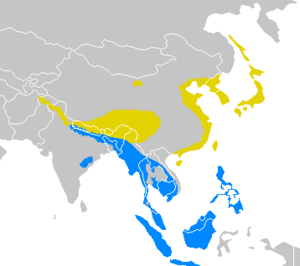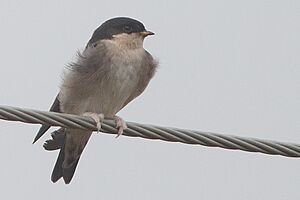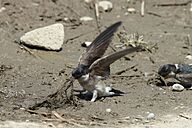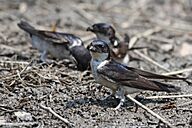Asian house martin facts for kids
Quick facts for kids Asian house martin |
|
|---|---|
 |
|
| In Taiwan | |
| Conservation status | |
| Scientific classification | |
| Genus: |
Delichon
|
| Species: |
dasypus
|
 |
|
| Distribution of Asian house martin Breeding Non-breeding | |
The Asian house martin (Delichon dasypus) is a small bird that flies long distances. It belongs to the swallow family. This bird has a blue-black back and a white patch above its tail. Its belly is a light grey.
There are three types, or subspecies, of the Asian house martin. They live and have their babies in the Himalayas and across central and eastern Asia. When winter comes, they fly to warmer places. They often go to lower mountains or Southeast Asia. This bird is quite common in many areas. Its numbers are even growing in some northern parts of Siberia. Because of this, scientists are not worried about it disappearing.
Asian house martins like to live in groups called colonies. They build their nests out of mud. These nests are usually found under ledges on cliffs or on the sides of buildings. Both the male and female birds help build the nest. They also take turns sitting on the three or four white eggs. Once the chicks hatch, both parents feed them. Asian house martins eat small insects. They usually catch these insects while flying high in the air. Sometimes, they even pick up food like tiny springtails or larvae from the ground.
Contents
About the Asian House Martin's Name
The Asian house martin was first described in 1850. A French naturalist named Charles Lucien Bonaparte gave it the name Chelidon dasypus. Soon after, it was moved to a new group, or genus, called Delichon. This was done by Frederic Moore and Thomas Horsfield in 1854.
The name Delichon is a mixed-up version of an old Greek word. That word, chelīdōn, means "swallow." The second part of its name, dasypus, comes from a Greek word meaning "rough-legged." The Asian house martin is closely related to two other birds. These are the Nepal house martin and the common house martin.
Different Types of Asian House Martins
There are three main types, or subspecies, of the Asian house martin:
- D. d. dasypus: This is the original type described by Bonaparte. It lives in eastern Russia and nearby islands.
- D. d. cashmeriensis: This type lives in the Himalayas and central Asia. An English ornithologist named John Gould described it in 1858.
- D. d. nigrimentalis: This type is found in southeastern China. A German ornithologist named Ernst Hartert described it in 1910.
What Does the Asian House Martin Look Like?
An adult Asian house martin is about 12 centimeters (5 inches) long. Its back is a dark, shiny blue-black. It has a bright white patch above its tail. Its belly is white with a grey tint. Its tail is slightly forked, meaning it has a small V-shape. The wings are brownish-black on top and grey-brown underneath.
The bird's legs and feet are pinkish-brown and covered with white feathers. Its eyes are brown, and its beak is black. Males and females look very similar. Young birds are not as shiny. They have dark brown backs and grey-white bellies.
How to Tell Them Apart
The D. d. cashmiriensis type has a brighter blue back and a whiter patch above its tail. The D. d. nigrimentalis type is the smallest of the three.
You can tell the Asian house martin apart from the similar Nepal house martin. The Nepal house martin has a black chin and a squarer tail. The Asian house martin is also similar to the common house martin. However, the Asian house martin is darker underneath. Its tail is also less forked than the common house martin's.
Their Calls and Songs
The Asian house martin's song sounds like a soft, metallic trill or a high-pitched twitter. Its call is a dry, metallic "cheep." It often has two or three parts. Their sounds are similar to the common house martin's, but a bit rougher.
Where Do Asian House Martins Live?
The D. d. dasypus type of Asian house martin lives in southeastern Russia, the Kuril Islands, Japan, and sometimes Korea. For winter, they fly to places like the Malay Peninsula, Borneo, the Philippines, Java, and Sumatra. Some even stay near hot springs in Japan.
The D. d. cashmeriensis type lives in the Himalayas. This area stretches from Afghanistan to Sikkim and into Tibet and parts of China. They are found at high places, usually between 2,400 to 4,000 meters (7,900 to 13,000 feet) high. These birds do not fly as far for winter. They mostly move to lower parts of the Himalayas. Some go to the plains of northeastern India and Bangladesh. A few travel further to Myanmar and northern Thailand.
The third type, D. d. nigrimentalis, lives in southeastern China and southern Siberia. We don't know exactly where they go for winter. However, birds in Taiwan just move to lower areas during the colder months. Asian house martins have even been seen as far west as the United Arab Emirates.
Their Favorite Homes
Asian house martins prefer to live in valleys and deep cuts in mountains. They also like coastal cliffs. These places offer natural caves or cracks where they can build nests. They will also nest on big buildings like temples, hotels, or power stations. In winter, they move to lower, open areas or hilly countryside.
How Asian House Martins Live
Building Nests and Raising Chicks
The Asian house martin builds its nest on cliffs. They often form colonies, with many nests close together. These nests are usually under an overhang on a vertical cliff. They also often nest on large buildings like temples and bridges.
The nest is a deep cone made of mud. It is lined with grasses or feathers. Unlike some of their relatives, Asian house martins often leave their nests partly open. This makes them look like a deeper version of a barn swallow's nest. In one study, half of the nests found were of this open type.
A female Asian house martin usually lays three or four plain white eggs. Sometimes, she might lay up to six. Each egg is about 20 mm by 14 mm (0.8 by 0.6 inches) and weighs about 2.1 grams (0.07 ounces). We don't know exactly how long it takes for the eggs to hatch or for the chicks to be ready to fly. However, it's probably similar to the common house martin. For them, eggs hatch in 14 to 16 days. Chicks then fly away after another 22 to 32 days. Both male and female birds help build the nest. They also share the job of sitting on the eggs and feeding the young birds.
What Do They Eat?
Asian house martins eat insects they catch while flying. They usually fly high in the air to find their food. They mostly eat small flies, aphids, and Hymenoptera like winged ants. They also catch many other insects. These include Lepidoptera (like butterflies and moths), beetles, and lacewings. Sometimes, they even pick up tiny springtails and larvae from the ground.
Who Hunts Them?
Birds can have tiny creatures living on them, like fleas or lice. They can also have tiny sickness-causing germs inside them. The Asian house martin can carry a type of flea called the house martin flea. They have also shown signs of a bird version of malaria.
Not much is known about what animals hunt the Asian house martin. However, their predators are probably similar to those of the common house martin. These might include fast-flying falcons, like the Oriental hobby. These birds are quick enough to catch martins in the air.
Is the Asian House Martin Safe?
The Asian house martin lives in a very large area. This area does not seem to be getting smaller. The number of these birds also seems to be steady. Even though we don't know the exact total number, it's clear there are many of them.
Because their range is so big (more than 20,000 square kilometers or 7,700 square miles) and there are more than 10,000 adult birds, they are not considered in danger. The IUCN (a group that checks on animals) says they are of Least Concern. This means they are not at risk of disappearing. In fact, this bird is common in many places. It is even spreading its living area northward in southern Siberia.





